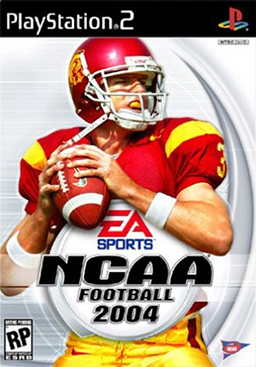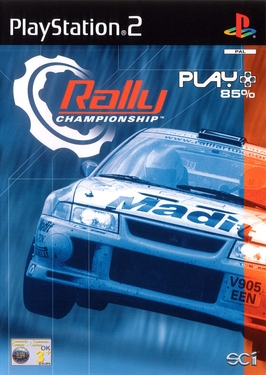
The Simpsons: Road Rage is a 2001 video game based on the animated television series The Simpsons, and is part of a series of games based on the show. It was released for PlayStation 2, Xbox and GameCube. A Game Boy Advance version was released in 2003.

Tak and the Power of Juju is an action-adventure platform video game developed by Avalanche Software and published by THQ for the GameCube, PlayStation 2 and Game Boy Advance. The game was released in North America on October 15, 2003 and in Europe on March 12, 2004.

WWE WrestleMania XIX is a professional wrestling video game released for the GameCube by THQ in 2003. Based on the professional wrestling promotion World Wrestling Entertainment (WWE), it is the sequel to WWE WrestleMania X8. The roster consists of around sixty-nine WWE wrestlers between May 2002 and March 2003, as the WWE was beginning to shift its momentum from the Attitude Era into the Ruthless Aggression Era.

Burnout is a 2001 racing video game developed by Criterion Games and published by Acclaim Entertainment for the PlayStation 2, GameCube and Xbox.

18 Wheeler: American Pro Trucker, known in Japan as 18 Wheeler, is an arcade game developed by Sega AM2 and distributed by Sega. The game was released in arcades in 2000 and ported to the Dreamcast in 2001. It was released for the PlayStation 2 in 2001 and GameCube in 2002 by Acclaim Entertainment. Sega followed up on the success of 18 Wheeler with a sequel, The King of Route 66, which was released in the arcades in 2002 and ported to the PlayStation 2. This was one of the final arcade games to be ported to the Dreamcast after its discontinuation, before Sega became a third-party developer.

Burnout 2: Point of Impact is a 2002 racing video game developed by Criterion Games and published by Acclaim Entertainment for PlayStation 2, GameCube and Xbox. It is the sequel to the 2001 video game Burnout and the second title in the Burnout series. It was the last Burnout game to be released on the GameCube and the series would not see a release on a Nintendo platform until the release of Burnout Legends in 2005. The game also marked Acclaim's last entry in the Burnout series, as Acclaim would go bankrupt in 2004; the rest of the series would be published by Electronic Arts.

NBA Live 2003 is the 2002 installment of the NBA Live video games series. The cover features Jason Kidd as a member of the New Jersey Nets. The game was developed by EA Canada and released on October 8, 2002 for the PlayStation, PlayStation 2, Xbox, and GameCube consoles and November 14, 2002 for Microsoft Windows. It was the last NBA Live game to be released on the original PlayStation. The game includes a soundtrack, which is the first video game soundtrack in history to be certified Platinum by the RIAA, selling over 1,300,000 copies worldwide.

Tiger Woods PGA Tour 2004 is a sports video game developed by EA Redwood Shores for the GameCube, PlayStation 2 and Xbox versions, Headgate Studios for the Microsoft Windows version, and Backbone Emeryville for the Game Boy Advance and N-Gage versions, and published by EA Sports for GameCube, Microsoft Windows, PlayStation 2, Xbox, Game Boy Advance and N-Gage.

NASCAR: Dirt to Daytona is a racing simulator developed by Monster Games and published by Infogrames in November 2002 for the PlayStation 2 and GameCube. It features NASCAR's Dodge Weekly Racing Series, Featherlite Modified Tour, Craftsman Truck Series, and the NASCAR Cup Series. The Dodge Weekly Racing Series and Featherlite Modified Tour rosters consist of generic fantasy drivers. The Craftsman Truck Series also features fantasy drivers alongside real ones. The unique feature of having to work your way up through the ranks from the low tier Weekly Racing Series to the Cup Series would later return in EA Sports' NASCAR 2005: Chase for the Cup.

Legends of Wrestling II is a professional wrestling video game developed by Acclaim Studios Salt Lake City, published by Acclaim Entertainment, and released on November 26, 2002, for both the PlayStation 2 and GameCube. It was later released for the Xbox on December 5, 2002. It is the sequel to the 2001 professional wrestling video game Legends of Wrestling. Legends II contains 25 wrestlers that were not in the first game, though also excludes Rob Van Dam, presumably because he had recently been signed to a WWE contract. The game does contain Eddie Guerrero who, although unemployed at the time, re-signed with WWE by the time the game was released. A Game Boy Advance version of the game was released on November 25, 2002. It was the last game developed by Acclaim's Salt Lake City studio before its closure in December 2002.

ATV: Quad Power Racing 2 is a racing video game developed by Climax Brighton and published by Acclaim Entertainment under their AKA Acclaim label for PlayStation 2, GameCube and Xbox. It's a sequel to ATV: Quad Power Racing. The game is notable for its inclusion of a three-wheeled ATV, not seen in any other video games, and not sold in the real world since the late 1980s.

Big Mutha Truckers is an open world racing video game developed by British studio Eutechnyx and released in 2002. Set in fictional Hick County, the game revolves around completing trips between cities, delivering goods, and competing in races while at the helm of a semi truck. The game is available on GameCube, Xbox, PlayStation 2, and Microsoft Windows. It met with middling critical and commercial reception, due to repetitive gameplay, dated graphics, and lackluster sound. The game uses Steppenwolf's "Born to Be Wild" as its theme song. The game's sequel is Big Mutha Truckers 2. A different game of the same name was developed by Italian company Raylight Studios and released for the Game Boy Advance and Nintendo DS.

Dark Summit is a 2001 snowboarding video game released by Radical Entertainment.

FIFA Football 2004, also known as FIFA Soccer 2004 in North America, is a football simulation video game developed by EA Canada and published by Electronic Arts. It was released in October 2003 with the tagline "Create Brilliance".

Hot Wheels: World Race is a racing game developed by Climax Brighton and published by THQ. It is based on the television series Hot Wheels: World Race that was released by Hot Wheels and Mainframe Entertainment, and 35 Hot Wheels toy automobiles were released in conjunction with the television series to coincide with the 35th anniversary of the creation of the franchise.

NCAA Football 2004 is an American football video game released in 2003 by Tiburon. It is the successor to NCAA Football 2003 in the NCAA Football series. The player on the cover is former USC quarterback Carson Palmer. The game is available for play with the N-Gage. Commentators are Brad Nessler, Kirk Herbstreit and Lee Corso. The game is an EA Sports Bio game, and is compatible with other games with the feature.

NHL 2K3 is an ice hockey video game developed for the GameCube, PlayStation 2, and Xbox by Treyarch and published by Sega. Jeremy Roenick is on the cover. It is the only game in the NHL 2K series to be released for GameCube. NHL 2K3 uses ESPN's presentation and was the first hockey game with support for PS2 Online and Xbox Live online services. The rosters are from the 2002–2003 NHL season.

Rally Championship is a rally video game. It was released for PlayStation 2 in 2002 and GameCube in 2003. It is developed by Warthog Games and published by SCi. It is the last game in the Rally Championship series. The game is a sequel to the 2001 game Rally Championship Xtreme. It is the first game in the series not published by Europress and the first game not released on the PC.

MX Superfly featuring Ricky Carmichael, released as MX Super Fly in PAL regions, is a motorcross racing game developed by Pacific Coast Power & Light and published by THQ for the Xbox, PlayStation 2, and GameCube. It is the second installment of THQ's MX trilogy and a sequel to MX 2002 featuring Ricky Carmichael, garnering professional motorcross racer Ricky Carmichael's endorsement like its predecessor.



















